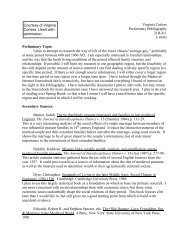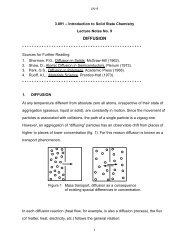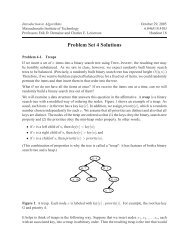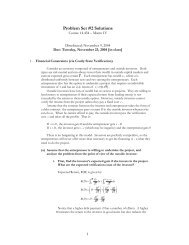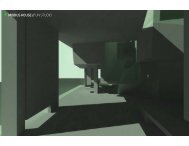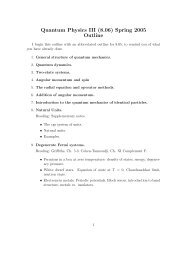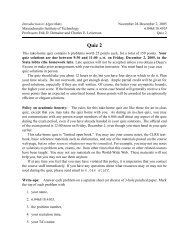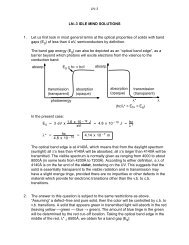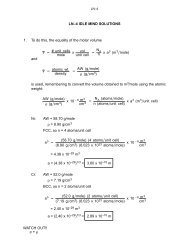3.091 â Introduction to Solid State Chemistry Lecture Notes No. 2 ...
3.091 â Introduction to Solid State Chemistry Lecture Notes No. 2 ...
3.091 â Introduction to Solid State Chemistry Lecture Notes No. 2 ...
- No tags were found...
You also want an ePaper? Increase the reach of your titles
YUMPU automatically turns print PDFs into web optimized ePapers that Google loves.
LN–2formation. However, with two covalencies carbon will not yield the desirable octetconfiguration. Such a configuration can be obtained if one of the two 2s electrons is“promoted” in<strong>to</strong> the empty 2p z orbital since this process results in four singly occupiedorbitals - all of which, being singly occupied, are capable of bond formation. Thedissimilar singly occupied orbitals can assume (and therefore will assume) upon bondformation a lower energy configuration involving a process called hybridization wherebythe four orbitals (of two different types) hybridize in<strong>to</strong> four identical orbitals of maximumequal spacing from each other (fig. 8). Thus the hybridized orbitals (sp 3 hybrids) arelobes emanating from the carbon a<strong>to</strong>m in<strong>to</strong> the corners of a tetrahedron, forming bondangles of 109_28’. sp 3 hybridization is characteristic for carbon; however, other types ofhybridization, sp 2 and sp, are encountered in other elements as well. Boron, forexample, will tend <strong>to</strong> promote one of its two 2s electrons in<strong>to</strong> a 2p state and, byhybridization, form three equivalent sp 3 orbitals which assume planar orientation withband angles of 120_. Beryllium forms sp hybrid orbitals of linear orientation (the bondangle is 180_). All hybrid orbitals are capable of σ bond formation.The great diversity of carbon compounds (it forms more compounds than all the rest ofthe elements in the Periodic Table) can be attributed <strong>to</strong> the hybridization capability ofthe carbon orbitals (sp 3 , sp 2 and sp). As a consequence, carbon forms not onlyaxisymmetric σ bonds (through axial orbital overlap), but also π bonds (through lateralorbital overlap). In the compound ethane (H 2 C = CH 2 ), the interactive carbon a<strong>to</strong>msundergo sp 2 hybridization for a σ bond by overlap of two sp 2 hybrid orbitals and form, inaddition, a π bond by lateral overlap of the remaining non-hybridized p orbitals. (Doublebonds involve one σ and one π bond.) In acetylene (HC CH), we find sp hybridizationand, by axial overlap, σ bond formation as well as lateral overlap of the remainingnon-hybridized p x and p y orbitals which form two π bonds (fig. 9).23


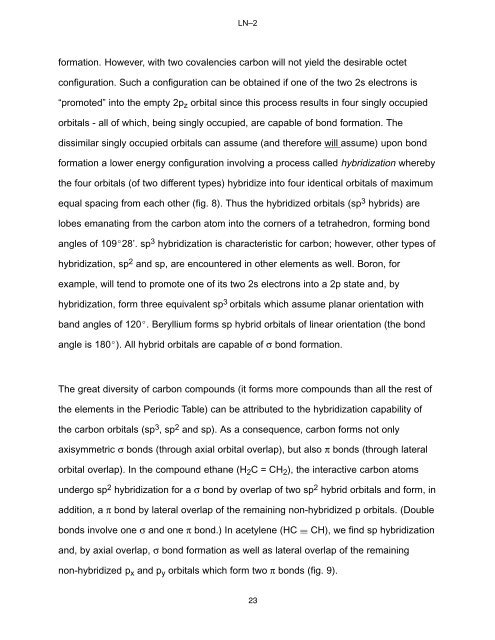
![18.03 Class 21, April 3 Fun with Fourier series [1] If f(t) is any decent ...](https://img.yumpu.com/51148985/1/190x245/1803-class-21-april-3-fun-with-fourier-series-1-if-ft-is-any-decent-.jpg?quality=85)

